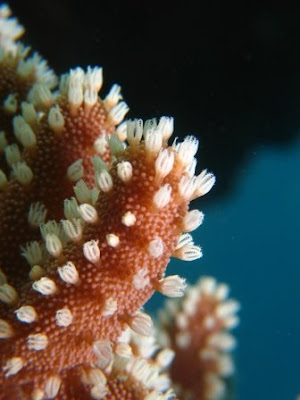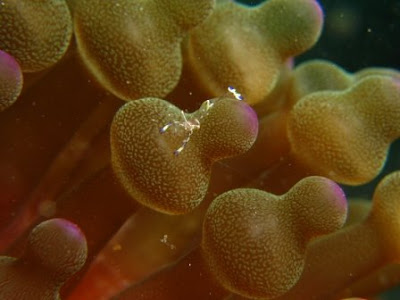"Coral reef ecosystem is the most diverse ecosystem in the sea. It is also known as the ‘Oasis’ of the sea or ‘The Rainsforest’ of the sea. The reef ecosystem supports abundance of life and many species thrives in this ecosystem. Although its coverage is small compare to the ocean floor, but its function is overwhelming than its size! The richness and importance of this reef ecosystem has been well documented and shown in various media formats. The most famous and known to all is the BBC documentary ‘The Blue Planet’, the Walt-Disney animation ‘Finding Nemo’ and also by Jacques Cousteau expedition team. Even the famous coral reef ecosystem in Malaysia, Sipadan Island was discovered by Jacques Cousteau himself! Malaysia is in the Coral Hotspot of the world and the number of coral species is more than 300 species. According to Jen Veron, the author of ‘Corals in Space & Time’, the north of Sabah is part of the ‘Coral Triangle’, which housed most of the species in the world and new species is still being discover. Malaysia have 42 islands which has being gazzetted as Marine Parks, and have been placed under governance of newly established Marine Park Department of Malayisa This Department is responsible in safeguarding, and manage the coral reefs from various activities which can degrade the reef ecosystem in Malaysia. Nevertheless, there are still many islands flourished with beautiful coral reefs and submerged coral reef ecosystem which is not a marine park, such as Pulau Jarak, Pulau Perak and the submerge reefs in Malaysian waters of the South China Sea. In 2004, the Ministry of Science, Technology & Inovation (MOSTI) has funded an expedition to explore the wonders of the coral reefs in Malaysia’s submerged reef in the South China Sea. The National University of Malaysia (UKM) in particular researchers from the Ocean Science Programme and Marine Ecosystem Research Centre (EKOMAR) were given the privilege to contribute to the expedition, of which all of them were overwhelmed by the pristine and richness of the coral reef ecosystem that proudly is in Malaysian waters.
Coral reefs are a source of food and livelihood for at least 100 million people worldwide, support major industries, play a key role in stabilizing coastlines, and their high species and genetic diversity rivals that of tropical rainforest. This biodiversity is now just beginning to be exploited in search for bioactive compounds that could benefit humankind. Prostaglandins, which is a natural product chemicals, contain in gorgonian has a wide range of clinical applications in assisting medical emergencies. Coral reef ascidians or also known as sea squirt, is also known to contain Didemnin B, which is use widely to battle against leukemia, varieties of human tumors, viruses and carcinomas. There are more natural chemical products constantly being discovered from coral reefs, and many more cures to be discovered, which makes them utterly important and should be protected. Coral reefs are also home to many species of reef fishes. It is known that the standing stocks of the coral reef fishes are about 30-40 times greater than standing stocks on demersal fishing grounds in Southeast Asia, the Mediterranean, or other temperate regions.
Coral reef ecosystem is consisting of reef building organisms, which are the corals, and many other co-exist organisms that form a complex ecosystem. Corals are the functional group that has contributed significantly to coral reef ecosystems for at least 200 million years ago. They have been known in building the primary structure of entire reefs and islands. Corals is classified as ‘Animal’, which means they are neither rocks nor plants, as it is often perceived by many. They are colonies of coral polyps with naturally embedded with symbiotic algae living in its mesoglea soft tissue providing nutrients by conducting photosynthesis. This algae is known as zooxanthellae, a kind of domain Dinoflagelate (Symbiodinium microadriaticum). The others associated communities of the corals, such as the giant clams, sea cucumber, sponges, sea anemones also plays important role in the ecology of this ecosystems. The molluscs or shells and sponges are the natural filters for the reefs. Their feeding mechanisms, which is filter feeding, helps in maintaining the turbidity of the crystal clear waters of the coral reefs. Sponges also acts like cement, where it bonds the coral structure together which strengthen the coral reef framework. Algae in the reefs helps in recycling nutrients and starfish (Fromia spp) recycle the organic materials found on the sea bed. Sea cucumber acts like a vacuum cleaner, where it feeds on the organic materials on the seafloor. The sea urchin is the gardener of the reefs where it feeds on algae and helps in maintaining the algae from overpopulating the reefs. There are also other non-conspicuous organisms, or also known as cryptic organisms such as the trapeziid crab and the cleaner shrimp which is also plays an important role in the reef ecosystem. The cleaner shrimp, Periclemenes spp., can be found living in between corals, such as Pocillopora and sea anemone such as the magnificient sea anemone, Heteractis magnifica. They helps preen the ‘house’ which they live within and receive foods and protection from it, this relationship is also known as symbiotic relationship. Besides preening, they are also the first defence for corals, such as Pocillopora spp., has against Crown-of-torns (Acanthaster planci). The complexity of the coral reefs ecosystem makes it the ideal place for many marine organisms to thrive and survive. It is essential for everybody, all woks of life, all level of education, to understand the importance of coral reefs, in order for all of us to protect it."
Coral reefs are a source of food and livelihood for at least 100 million people worldwide, support major industries, play a key role in stabilizing coastlines, and their high species and genetic diversity rivals that of tropical rainforest. This biodiversity is now just beginning to be exploited in search for bioactive compounds that could benefit humankind. Prostaglandins, which is a natural product chemicals, contain in gorgonian has a wide range of clinical applications in assisting medical emergencies. Coral reef ascidians or also known as sea squirt, is also known to contain Didemnin B, which is use widely to battle against leukemia, varieties of human tumors, viruses and carcinomas. There are more natural chemical products constantly being discovered from coral reefs, and many more cures to be discovered, which makes them utterly important and should be protected. Coral reefs are also home to many species of reef fishes. It is known that the standing stocks of the coral reef fishes are about 30-40 times greater than standing stocks on demersal fishing grounds in Southeast Asia, the Mediterranean, or other temperate regions.
Coral reef ecosystem is consisting of reef building organisms, which are the corals, and many other co-exist organisms that form a complex ecosystem. Corals are the functional group that has contributed significantly to coral reef ecosystems for at least 200 million years ago. They have been known in building the primary structure of entire reefs and islands. Corals is classified as ‘Animal’, which means they are neither rocks nor plants, as it is often perceived by many. They are colonies of coral polyps with naturally embedded with symbiotic algae living in its mesoglea soft tissue providing nutrients by conducting photosynthesis. This algae is known as zooxanthellae, a kind of domain Dinoflagelate (Symbiodinium microadriaticum). The others associated communities of the corals, such as the giant clams, sea cucumber, sponges, sea anemones also plays important role in the ecology of this ecosystems. The molluscs or shells and sponges are the natural filters for the reefs. Their feeding mechanisms, which is filter feeding, helps in maintaining the turbidity of the crystal clear waters of the coral reefs. Sponges also acts like cement, where it bonds the coral structure together which strengthen the coral reef framework. Algae in the reefs helps in recycling nutrients and starfish (Fromia spp) recycle the organic materials found on the sea bed. Sea cucumber acts like a vacuum cleaner, where it feeds on the organic materials on the seafloor. The sea urchin is the gardener of the reefs where it feeds on algae and helps in maintaining the algae from overpopulating the reefs. There are also other non-conspicuous organisms, or also known as cryptic organisms such as the trapeziid crab and the cleaner shrimp which is also plays an important role in the reef ecosystem. The cleaner shrimp, Periclemenes spp., can be found living in between corals, such as Pocillopora and sea anemone such as the magnificient sea anemone, Heteractis magnifica. They helps preen the ‘house’ which they live within and receive foods and protection from it, this relationship is also known as symbiotic relationship. Besides preening, they are also the first defence for corals, such as Pocillopora spp., has against Crown-of-torns (Acanthaster planci). The complexity of the coral reefs ecosystem makes it the ideal place for many marine organisms to thrive and survive. It is essential for everybody, all woks of life, all level of education, to understand the importance of coral reefs, in order for all of us to protect it."































































